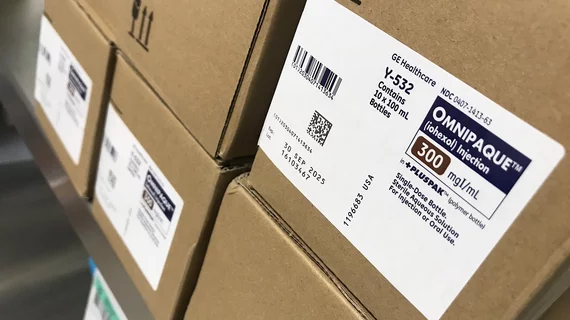Two years after the contrast shortage, how have supply preservation tactics fared?
When the imaging industry grappled with contrast shortages in 2022, organizations across the world deployed mitigation strategies to ensure that patients who needed such supplies the most could get them. A new analysis looks at how use of the imaging agents has changed since then.
More than two years after the onset of the shortage, some of the steps that were taken to optimize contrast use at the time continue to preserve supplies today, according to a paper published in the Journal of the American College of Radiology.
Authors of the article worked within a large Harvard-affiliated health system consisting of 12 sites. Within this organization, which completes over 1 million imaging exams annually, contrast mitigation strategies resulted in a 5% drop in the use of contrast-enhanced studies during the shortage. Although these figures mostly recovered once the shortage had resolved, the reduction in contrast used per patient persisted, resulting in significant and long-lasting supply preservation within the health system.
The group monitored trends in contrast studies within their organization for a period of 17 months—between January 2022 and the end of June 2023—to determine how contrast was utilized before, during and after the onset of the shortage.
The months prior to the implementation of mitigation tactics included just over 150,000 CT scans, 57.7% of which used contrast. When the supply chain was disrupted, the health system implemented new protocols that determined patients’ contrast dosage based on their weight; sites that were capable of doing so also used multi-dose vials to preserve supplies, as they allow for customizable dosing.
“Similar to implementing harmonized CT protocols, establishing standardized doses for intravenous contrast media leads to more consistent image quality and reproducibility across scanners and sites,” Daniel I. Glazer, from the Department of Radiology at Brigham and Women’s Hospital in Boston, and colleagues note. “Reducing unwarranted variation is desirable in any multisite system and leads to increased value.”
Amid the shortage, overall contrast utilization dropped by around 5% throughout the health system. Contrast doses were reduced as well, dropping from an average of 89.3 mL per exam to 78.0 mL—a nearly 13% decrease in volume. During the initial intervention period (three months), the team estimates that 750,000 mL of contrast was conserved.
Although contrast utilization largely recovered after the shortage resolved, the reduction in volume persisted at 9 out of the 12 sites.
To learn more about the study, click here.

